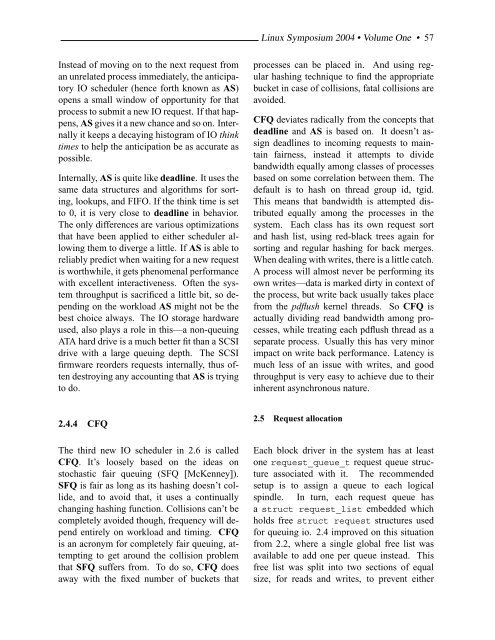Create successful ePaper yourself
Turn your PDF publications into a flip-book with our unique Google optimized e-Paper software.
<strong>Linux</strong> Symposium 2004 • Volume <strong>One</strong> • 57<br />
Instead of moving on to the next request from<br />
an unrelated process immediately, the anticipatory<br />
IO scheduler (hence forth known as AS)<br />
opens a small window of opportunity for that<br />
process to submit a new IO request. If that happens,<br />
AS gives it a new chance and so on. Internally<br />
it keeps a decaying histogram of IO think<br />
times to help the anticipation be as accurate as<br />
possible.<br />
Internally, AS is quite like deadline. It uses the<br />
same data structures and algorithms for sorting,<br />
lookups, and FIFO. If the think time is set<br />
to 0, it is very close to deadline in behavior.<br />
<strong>The</strong> only differences are various optimizations<br />
that have been applied to either scheduler allowing<br />
them to diverge a little. If AS is able to<br />
reliably predict when waiting for a new request<br />
is worthwhile, it gets phenomenal performance<br />
with excellent interactiveness. Often the system<br />
throughput is sacrificed a little bit, so depending<br />
on the workload AS might not be the<br />
best choice always. <strong>The</strong> IO storage hardware<br />
used, also plays a role in this—a non-queuing<br />
ATA hard drive is a much better fit than a SCSI<br />
drive with a large queuing depth. <strong>The</strong> SCSI<br />
firmware reorders requests internally, thus often<br />
destroying any accounting that AS is trying<br />
to do.<br />
processes can be placed in. And using regular<br />
hashing technique to find the appropriate<br />
bucket in case of collisions, fatal collisions are<br />
avoided.<br />
CFQ deviates radically from the concepts that<br />
deadline and AS is based on. It doesn’t assign<br />
deadlines to incoming requests to maintain<br />
fairness, instead it attempts to divide<br />
bandwidth equally among classes of processes<br />
based on some correlation between them. <strong>The</strong><br />
default is to hash on thread group id, tgid.<br />
This means that bandwidth is attempted distributed<br />
equally among the processes in the<br />
system. Each class has its own request sort<br />
and hash list, using red-black trees again for<br />
sorting and regular hashing for back merges.<br />
When dealing with writes, there is a little catch.<br />
A process will almost never be performing its<br />
own writes—data is marked dirty in context of<br />
the process, but write back usually takes place<br />
from the pdflush kernel threads. So CFQ is<br />
actually dividing read bandwidth among processes,<br />
while treating each pdflush thread as a<br />
separate process. Usually this has very minor<br />
impact on write back performance. Latency is<br />
much less of an issue with writes, and good<br />
throughput is very easy to achieve due to their<br />
inherent asynchronous nature.<br />
2.4.4 CFQ<br />
<strong>The</strong> third new IO scheduler in 2.6 is called<br />
CFQ. It’s loosely based on the ideas on<br />
stochastic fair queuing (SFQ [McKenney]).<br />
SFQ is fair as long as its hashing doesn’t collide,<br />
and to avoid that, it uses a continually<br />
changing hashing function. Collisions can’t be<br />
completely avoided though, frequency will depend<br />
entirely on workload and timing. CFQ<br />
is an acronym for completely fair queuing, attempting<br />
to get around the collision problem<br />
that SFQ suffers from. To do so, CFQ does<br />
away with the fixed number of buckets that<br />
2.5 Request allocation<br />
Each block driver in the system has at least<br />
one request_queue_t request queue structure<br />
associated with it. <strong>The</strong> recommended<br />
setup is to assign a queue to each logical<br />
spindle. In turn, each request queue has<br />
a struct request_list embedded which<br />
holds free struct request structures used<br />
for queuing io. 2.4 improved on this situation<br />
from 2.2, where a single global free list was<br />
available to add one per queue instead. This<br />
free list was split into two sections of equal<br />
size, for reads and writes, to prevent either

















